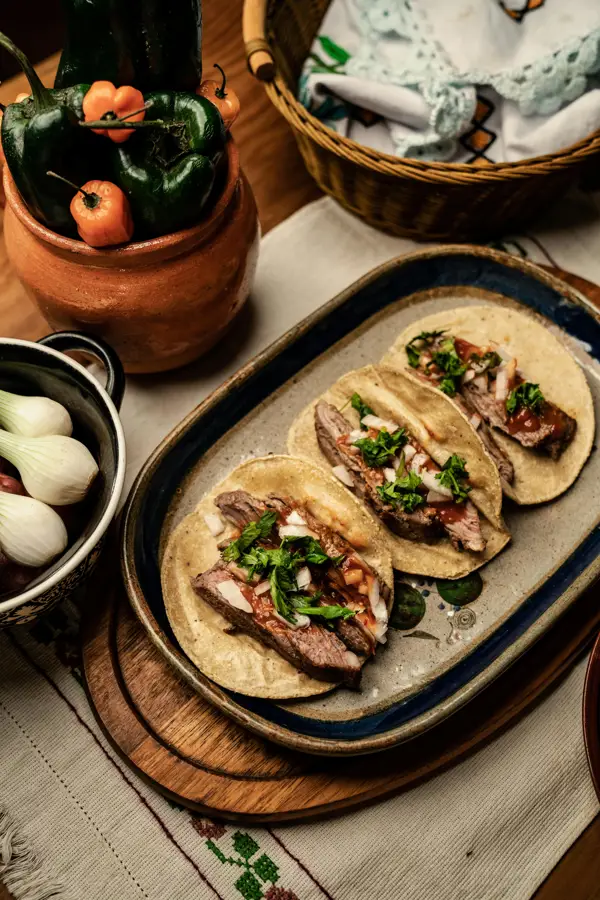The aroma of sizzling carne asada, the vibrant crunch of fresh cilantro, the tangy kick of salsa – these are the hallmarks of the authentic Mexican taco, a culinary experience far richer than just a simple street food. Tacos, far from being a recent invention, boast a history deeply intertwined with Mexican culture, spanning centuries. Their origins can be traced back to the pre-Hispanic era, with evidence suggesting that the indigenous peoples of Mexico consumed corn-based tortillas filled with various ingredients long before the arrival of the Spanish. While the precise form may have evolved, the fundamental concept of a filled tortilla remains constant.
The Spanish conquest, while altering many aspects of Mexican life, also influenced the evolution of the taco. The introduction of new ingredients like beef and pork broadened the culinary possibilities, leading to the diverse range of fillings we see today. Over time, regional variations emerged, reflecting the unique agricultural landscapes and culinary traditions of different parts of Mexico. From the al pastor tacos of Puebla, marinated in achiote paste and cooked on a vertical spit, to the fish tacos of Baja California, each region boasts its own distinct style and flavors. This remarkable diversity is a testament to the enduring adaptability and cultural significance of the taco.
Today, the taco reigns supreme as a global culinary icon. The United States alone consumes billions of tacos annually, a testament to its widespread popularity. This popularity isn’t just about taste; tacos represent a significant part of Mexican cultural identity, a symbol of community and shared experiences. Family gatherings often revolve around taco preparation and consumption, reinforcing its social importance. Beyond the borders of Mexico, the taco has become a powerful symbol of Mexican heritage, bridging cultures and enriching culinary landscapes worldwide. This recipe aims to bring the authentic taste and spirit of Mexican tacos into your own kitchen, allowing you to experience the rich history and cultural significance of this beloved dish firsthand.
Ingredients and Measurements
This recipe yields approximately 12 tacos. Adjust quantities as needed for a larger or smaller batch. The beauty of tacos is their adaptability, so feel free to substitute ingredients based on your preferences and what’s available.
For the seasoned ground beef:
- 1 lb ground beef (80/20 blend recommended for optimal flavor and juiciness)
- 1 large onion, finely chopped (approximately 1 cup)
- 2 cloves garlic, minced
- 1 tablespoon chili powder
- 1 teaspoon cumin
- 1/2 teaspoon smoked paprika
- 1/4 teaspoon cayenne pepper (optional, for added heat)
- 1 teaspoon dried oregano
- 1/2 teaspoon salt
- 1/4 teaspoon black pepper
- 1 (14.5 ounce) can diced tomatoes, undrained
- 1/2 cup beef broth
For the toppings: The possibilities are endless! These are suggestions; feel free to add your favorites.
- 1 cup shredded Monterey Jack cheese
- 1 cup shredded lettuce, finely chopped
- 1/2 cup chopped cilantro
- 1 ripe avocado, diced
- 1 lime, cut into wedges
- 1/2 cup pico de gallo (recipe below)
- Your favorite hot sauce
For the Pico de Gallo:
- 1 cup diced tomatoes
- 1/2 cup finely chopped red onion
- 1/4 cup chopped cilantro
- 1 jalapeño pepper, seeded and minced (adjust to your spice preference)
- 1 tablespoon lime juice
- 1/4 teaspoon salt
For the corn tortillas:
- 12 corn tortillas (6-inch diameter recommended)
Important Notes:
- Fresh ingredients are key to achieving authentic Mexican flavor. Use high-quality spices and fresh herbs whenever possible.
- Don’t overcook the ground beef. Drain off excess grease before adding the tomatoes and broth.
- Warm the tortillas gently before filling. You can heat them in a dry skillet, microwave, or oven. This makes them more pliable and less likely to break.
- Prepare your toppings in advance to streamline the assembly process. This is especially helpful when entertaining.
Equipment List
Creating authentic Mexican tacos at home requires the right tools to achieve optimal results. While you might already own much of this equipment, having the correct items will significantly enhance your cooking experience and the final product. This list details the essential and recommended equipment, with specifications where helpful.
Essential Equipment:
- Large Cast Iron Skillet (12-inch diameter): This is crucial for properly searing and crisping your carne asada or other taco fillings. The even heat distribution of cast iron is key to achieving a delicious crust.
- Sharp Chef’s Knife (8-inch blade): Precise cuts are essential for consistent cooking and attractive presentation. A high-quality chef’s knife will make your prep work much easier.
- Cutting Board (Large, sturdy): Opt for a large cutting board made of wood or plastic that is easy to clean. Avoid glass cutting boards as they can dull your knives quickly.
- Mixing Bowls (various sizes): You’ll need several mixing bowls for marinating meats, preparing your toppings, and combining ingredients for salsas or other accompaniments. Sizes ranging from 1.5-quart to 5-quart will cover most needs.
- Measuring Cups and Spoons: Accurate measurements are important for achieving the right flavor balance in your recipes. Invest in a good set of measuring cups and spoons.
- Tongs: Essential for safely handling hot meats and flipping them in the skillet.
- Spatula: A sturdy spatula is needed for scraping the bottom of the skillet and ensuring even cooking.
Recommended Equipment:
- Meat Thermometer: A reliable meat thermometer ensures your meat is cooked to the perfect internal temperature for food safety and optimal tenderness.
- Blender or Food Processor: This is helpful for making smooth salsas or guacamole. A food processor will be faster for larger batches.
- Comal (optional): A comal is a traditional Mexican griddle used for cooking tortillas directly over a heat source. It imparts a unique flavor and texture to the tortillas, but a dry skillet works well as a substitute.
- Tortilla Press (optional): If you’re making your own tortillas, a tortilla press will make the process much easier and more efficient. A rolling pin can be used as an alternative but requires more skill.
Important Note: Cleanliness is paramount in food preparation. Always wash your equipment thoroughly before and after use to maintain hygiene and prevent cross-contamination. Properly sharpened knives are safer and more efficient than dull ones. Consider investing in a honing steel to keep your knives sharp.
Preparation of Ingredients (e.g., chopping, marinating)
The success of authentic Mexican tacos hinges on fresh, high-quality ingredients prepared with care. This section details the preparation steps for achieving optimal flavor and texture.
Protein Preparation: Let’s start with the star of the show – the meat. For classic al pastor-style tacos, you’ll need about 2 lbs of pork shoulder, cut into 1-inch cubes. Marinate the pork for at least 4 hours, or preferably overnight, in a mixture of 1/2 cup of orange juice, 1/4 cup of pineapple juice, 2 tablespoons of chili powder, 1 tablespoon of cumin, 1 tablespoon of oregano, 1 teaspoon of garlic powder, 1 teaspoon of onion powder, 1/2 teaspoon of cayenne pepper (adjust to your spice preference), 1/4 cup of apple cider vinegar, and 2 tablespoons of olive oil. The longer it marinates, the more tender and flavorful the pork will be.
Onion and Cilantro Prep: Finely chop 1 large white onion and a large bunch of fresh cilantro. Aim for a consistent chop size for both to ensure even distribution throughout your tacos. Roughly chopping will result in uneven textures. You can also separate the cilantro leaves from the stems; many prefer the milder flavor of the leaves only.
Preparing the Peppers: For a vibrant flavor profile, use a combination of fresh peppers. We recommend 2 poblano peppers and 1 jalapeño pepper. Remove the stems and seeds from the peppers to control the level of spiciness. Finely chop the poblanos and finely mince the jalapeño. Remember to wear gloves when handling jalapeños, as the oils can irritate your skin.
Other Essential Ingredients: Prepare your toppings! For a classic experience, you’ll need to finely chop 2 Roma tomatoes. You should also have your corn or flour tortillas ready and warmed. Don’t forget the lime wedges for squeezing fresh lime juice over your tacos for added zest. Warming the tortillas gently on a comal or dry skillet prevents them from breaking when filled.
Pro Tip: For an extra layer of flavor, consider grilling or roasting your onions and peppers before adding them to your tacos. This caramelizes their sugars, adding a smoky sweetness to complement the savory meat.
With your ingredients meticulously prepared, you’re ready to assemble your authentic Mexican tacos! Enjoy the process and the delicious results.
Meat Cooking Techniques for Authentic Mexican Tacos
Achieving authentic Mexican taco flavor hinges significantly on proper meat preparation. Different cuts benefit from different cooking methods, impacting both texture and taste. Here, we explore some key techniques to help you master the art of taco meat.
Grilling: Grilling imparts a delicious smoky char and enhances the natural flavors of the meat. For carne asada (grilled steak), opt for a skirt steak (about 1.5 lbs) or flank steak (about 1.2 lbs). Marinate the steak for at least 30 minutes, preferably longer, in a mixture of 1/4 cup lime juice, 2 tablespoons olive oil, 1 tablespoon chili powder, 1 teaspoon cumin, 1 teaspoon oregano, salt, and pepper. Preheat your grill to medium-high heat. Grill the steak for 4-6 minutes per side for medium-rare, or longer depending on your preference. Remember to let the meat rest for 10 minutes before slicing against the grain for maximum tenderness.
Frying: Frying, particularly pan-frying, is excellent for achieving crispy textures, ideal for carne al pastor (marinated pork). Use boneless pork shoulder (about 2 lbs), cut into 1-inch cubes. Marinate the pork for at least 4 hours, or overnight, in a mixture of 1/2 cup achiote paste, 1/4 cup pineapple juice, 2 tablespoons orange juice, 2 cloves minced garlic, 1 tablespoon chili powder, 1 teaspoon cumin, salt, and pepper. Heat 2 tablespoons of vegetable oil in a large skillet over medium-high heat. Fry the pork in batches, ensuring not to overcrowd the pan, until browned and cooked through (about 8-10 minutes per batch). Avoid overcrowding the pan to ensure even browning and prevent steaming.
Slow Cooking: Slow cooking is perfect for tougher cuts of meat, allowing them to become incredibly tender and flavorful. For carnitas (slow-cooked pork), use a 3-4 lb pork shoulder. Season the pork generously with salt, pepper, cumin, and oregano. Place the pork in a slow cooker with 1 cup of chicken broth and cook on low for 8-10 hours, or until the pork is easily shredded. Once cooked, shred the pork and crisp it up in a skillet with a little oil for added texture. This step is crucial for achieving the ideal carnitas texture.
Important Note: Always use a meat thermometer to ensure your meat reaches a safe internal temperature. For beef, aim for 145°F (63°C); for pork, 145°F (63°C); and for poultry, 165°F (74°C).
Experiment with these techniques and adjust seasonings to your liking. The key to delicious authentic Mexican tacos is using high-quality ingredients and mastering the cooking process to achieve the perfect texture and flavor for your chosen meat.
Taco Assembly Instructions
Now that your delicious fillings and warm tortillas are ready, let’s assemble some authentic Mexican tacos! The key to a great taco is balance – a harmonious blend of textures and flavors. Don’t be afraid to experiment and find your perfect combination.
Warming your tortillas is crucial. You can achieve this by warming them briefly in a dry skillet over medium heat for about 30 seconds per side, or by steaming them in a microwave wrapped in a damp paper towel for 15-20 seconds. This makes them pliable and prevents them from cracking when you fill them.
Start with a base layer of your chosen protein. For example, if you’re using carne asada, aim for approximately 3-4 ounces of thinly sliced meat per taco. Too much protein will make the taco heavy and difficult to manage. Too little, and it will lack substance.
Next, add your chosen salsa. A tablespoon or two is usually sufficient, depending on your spice preference. Remember, you can always add more, but you can’t take it away! Consider layering different salsas for a complex flavor profile – a mild salsa verde followed by a spicier roja, for instance.
Incorporate your fresh toppings thoughtfully. Finely chopped cilantro (about 1 tablespoon), diced white onion (about 1 tablespoon), and shredded lettuce (about 1/4 cup) add freshness and texture. Consider adding other ingredients like pickled onions or radishes for extra zest. Don’t overload the taco with toppings; this can make it messy and difficult to eat.
A sprinkle of crumbled queso fresco (about 1 tablespoon) or cotija cheese adds a lovely salty, creamy counterpoint to the other flavors. A squeeze of lime juice (about 1/2 a lime) brightens the whole thing and adds a vital acidic element to balance the richness of the meat and cheese.
Fold your taco carefully. For soft corn tortillas, a simple fold is usually sufficient. For harder, crispier tortillas, you might need to use a slightly more complex folding technique to prevent them from breaking. Avoid overfilling, as this can make the taco difficult to handle and eat.
Serve immediately. Tacos are best enjoyed fresh, while the tortillas are still warm and the fillings are at their peak flavor. Enjoy your authentic Mexican tacos!
Pro Tip: Prepare all your fillings and toppings ahead of time and arrange them in separate bowls for easy assembly. This makes the process much quicker and less stressful, especially when entertaining guests.
Preparation of Toppings and Garnishes
The magic of a truly authentic Mexican taco lies not just in the filling, but in the vibrant array of toppings and garnishes. These elements allow for personalization and elevate the simple taco to a culinary masterpiece. Proper preparation is key to maximizing flavor and texture.
Pico de Gallo: A classic, this fresh salsa is incredibly easy to make. Combine 1 cup finely diced tomatoes, ½ cup finely chopped white onion, ½ cup chopped cilantro, 2 jalapeños (seeded and minced for less heat, or leave seeds for extra spice), and the juice of 1 lime. Season generously with salt. Let it sit for at least 15 minutes to allow the flavors to meld. This will yield approximately 2 cups of pico de gallo.
Guacamole: For creamy guacamole, mash 3 ripe avocados with ¼ cup finely chopped white onion, 2 tablespoons chopped cilantro, 1 tablespoon lime juice, and ½ teaspoon salt. Adjust the salt to your taste. For a smoother texture, use a fork to mash; for a chunkier texture, use a potato masher. You can add a diced jalapeño for extra heat. This recipe makes approximately 1 ½ cups of guacamole.
Quick-Pickled Onions: These add a delightful tangy crunch. Thinly slice ½ cup red onion. Combine with ¼ cup white vinegar, 2 tablespoons water, 1 tablespoon sugar, and a pinch of salt in a small bowl. Let it sit for at least 15 minutes, or even longer for a stronger flavor. The longer they pickle, the more intense the flavor becomes. Drain before using.
Shredded Lettuce: Use crisp iceberg or romaine lettuce. Wash thoroughly and shred finely using a knife or a food processor. Avoid over-shredding, as it can become mushy. Store in a colander lined with paper towels to remove excess moisture.
Cotija Cheese: Crumble cotija cheese, a firm, salty Mexican cheese, generously over your tacos. Don’t be shy with the cheese! Its salty, sharp flavor complements the other elements beautifully. Alternatively, you can use queso fresco.
Other Garnishes: Consider adding other garnishes such as chopped radishes, finely sliced carrots, or a squeeze of fresh lime juice just before serving. Remember that presentation matters – arrange your toppings attractively for an enhanced dining experience.
Storage: Store prepared toppings and garnishes separately in airtight containers in the refrigerator. Pico de gallo and guacamole are best consumed fresh, within a day or two. Pickled onions can last longer, up to a week.
Recommendations
For the best authentic flavor, use high-quality ingredients. Freshly squeezed lime juice makes a significant difference, as does using good quality corn tortillas. Don’t be afraid to experiment with different types of meat – al pastor, carnitas, or even a simple carne asada can all create delicious tacos. Remember to season generously!
These tacos are best served immediately after preparation to enjoy the warm tortillas and the fresh ingredients at their peak. Serve your tacos with a variety of toppings, such as chopped cilantro, diced white onion, shredded lettuce, pico de gallo, and your favorite salsa. A squeeze of fresh lime juice just before eating brightens the flavors beautifully.
For a complete meal, consider serving your tacos with classic Mexican sides. Rice and beans are excellent accompaniments, providing a hearty and flavorful contrast to the tacos. A simple Mexican rice with tomatoes and onions, or refried beans, will perfectly complement the meal. Guacamole or a fresh Mexican salad adds another layer of flavor and texture.
Leftover tacos can be stored in an airtight container in the refrigerator for up to 2 days. However, the tortillas may become soft. To refresh them, you can briefly warm them in a dry skillet or microwave before reheating the filling. It’s best to reheat the filling separately to prevent the meat from drying out.
Nutritional Information (per taco, approximate values will vary based on ingredients and portion sizes): Calories: 250-350, Protein: 15-25g, Fat: 10-20g, Carbohydrates: 25-35g. This information is an estimate and does not account for variations in ingredients or portion sizes. For precise nutritional information, use a nutrition calculator with your specific recipe details.
Important Note: The calorie and nutritional information provided is an approximation. The actual values will depend on the specific ingredients used, their quantities, and the cooking methods employed. For a more accurate analysis, use a nutrition tracking app or consult a registered dietitian.





